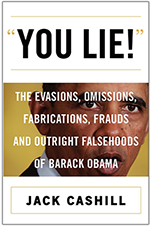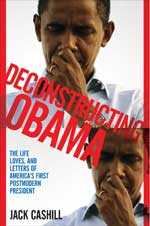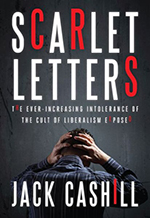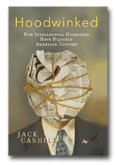What The Unearthed 1995 Video Tells Us About Obama
&
Further Thoughts on
Obama’s 1995 Video
Jack Cashill's newest book will be out August 4th:
“Scarlet Letters: The Ever-Increasing Intolerance of the Cult of Liberalism Exposed"
Pre-order
___
Get your copy of Jack Cashill's latest book, "You Lie!"

___
Get your copy of Deconstructing Obama

___
Jack Cashill's book:
Hoodwinked: How Intellectual Hucksters have Hijacked American Culture
© Jack Cashill
AmericanThinker.com - April 16, 2015
A professionally shot video of Barack Obama from 1995 has recently surfaced. Shot at the Cambridge Mass. Public Library, the video captures a skinny, youthful Obama promoting his then newly released memoir, Dreams from My Father.
In this hour-long presentation, Obama openly talks about his relationship with his mentor, Frank Marshall Davis, a Communist and pornographer. Perhaps more importantly, Obama gives us a much clearer picture about who he was in 1995, on the cusp of his political career, than we had seen before. Some observations:
The Obama of 1995 was not a very good speaker. He had a halting delivery, stuttered, was obviously nervous, and although congenial enough, could not tell a joke. What Obama did do well was read. He read a dramatic passage from his book for a full fifteen minutes uninterrupted and used multiple voices halfway credibly.
Over the years Obama’s handlers have exploited his ability to read and sheltered him as far as possible from impromptu speaking. Had Obama’s teleprompter malfunctioned during his breakthrough speech at the 2004 Democratic National Convention, he would not be president today. He has always depended on the eloquence of others, and he still cannot tell a joke.
The Obama of 1995 was not a firebrand, at least not on the surface. He presented himself to the small, roughly half black Cambridge audience as an optimistic, easy-going liberal. In the question and answer session, he distinguished himself from the more obviously angry black professor Cornel West. “Cornel West has to go back to his Bible. Got to have faith,” said Obama in a black accent almost as cringe-inducing as the one Hillary rolls out on occasion. In fact, Obama turned that accent on throughout the presentation, especially when answering questions from black women.
Obama’s allusion to the Bible was purely metaphoric. He made no reference to his much bruited Christian faith. He made no reference to Islam either. Despite his concession that white Americans were “basically decent,” Obama did not think they were “making a serious effort” to compensate for the “brutal experience” of black history. That “was going to cost some money,” and, according to Obama, “Americans don’t like to sacrifice.”
Obama made the supersized claim that “American culture at this point, what is truly American, is black culture to a large degree.” As evidence, he cited Pulp Fiction, a pop-art gangster movie with a surfer music sound track and an Italian-American director.
Obama’s “angry black man” is largely fictional. The one and only passage that Obama read details how he came to grips with the reality of being a black man in America. Much of it is fabricated, especially the part about his brooding black friend “Ray.”
Obama-friendly biographer David Maraniss tracked the real “Ray” down. His name is “Keith Kakaguwa.” Two years ahead of Obama at Punahou, Kakaguwa is only about one-fourth black. Maraniss describes Ray as the “first of several distorted or composite characters” in Dreams. According to Kakaguwa, he and Obama lived close to a carefree Hawaiian existence, not at all the tortured, race-scarred one Obama imagined.
The second of Obama’s guides to black life is more legitimate. Interestingly, Obama introduced him by his full name, Frank Marshall Davis. In that Obama wrote two adolescent poems about Davis—and Davis likely one about Obama—Davis may be the most real character in the book. It is a shame no one in the major media—not even Maraniss in an extended Washington Post series--thought to mention Davis before the 2008 election.
In the cited passage, Obama tells the story of how a “very aggressive” panhandler harassed “Toot,” his diminutive white grandmother. “Gramps” then tells Obama that Toot felt threatened because the aggressor was black. “The words were like a fist in my stomach,” wrote Obama. In 2008, he would compare Toot’s alleged racism to Jeremiah Wright’s to save his candidacy.
After this incident, Obama visited “Frank” to get the low down on white people. “What I’m trying to tell you is, your grandma’s right to be scared,” Davis tells Obama.
“She understands that black people have a reason to hate. That’s just how it is.” With these words of wisdom ringing in his ears, Obama heads into the night “utterly alone.”
Obama finished reading his passage with those two words. They were his way of telling black American audiences that their experience was his experience. He has never been very convincing at that. He keeps trying, however, even if it means yielding to every destructive race hustle the Jacksons and Sharptons of the world can conjure up.
Obama did not write “Dreams” unaided. In listening to Obama speak, one could not help but note the stark difference between the eloquence of the words he read and the tortured syntax of the words he spoke. Sentences like “Most black folks always have an open hand to individual whites” were not unusual in his talk.
What is more, in answering a question on how he organized his writing, Obama could not quite get his story straight. He never can. In this retelling, he initially planned to write an academic treatise on racial issues but at some point he shifted instead to a family history.
In fact, he claimed to have used his very generous advance from Simon & Schuster to go back to Kenya in 1992 “to do some more research because the last section of the book talks about Kenya.” Michelle, then his fiancée, went with him.
In October 1992, they married.
Obama missed the extended deadline, and Simon & Schuster asked for their money back in the summer of 1993. Obama’s agent, Jane Dystel, secured a new publisher, Times Book, a division of Random House. Obama still could not produce.
As bestselling mainstream biographer Christopher Andersen relates, Obama found himself deeply in debt and “hopelessly blocked.” At “Michelle’s urging,” Obama “sought advice from his friend and Hyde Park neighbor Bill Ayers.” What attracted the Obamas were “Ayers’s proven abilities as a writer” as evident in his 1993 book, To Teach.
According to Maraniss, Obama submitted the first draft of his memoir to Henry Ferris, the editor at his new publisher, some time in 1994. The draft did not include the final section of the book, the Kenya section. Before completing the book, Obama returned to Kenya or so he appears to have told Ferris.
Writes Maraniss, who interviewed Ferris, "Obama traveled to Kenya a second time for further research before turning in the last part of the book." The language here is clear. Obama traveled to Africa after the first submission but before the final one. This trip could have been no earlier than 1994 and not much later. Dreams was published in July 1995. In a White House interview with Maraniss, Obama confirmed this later trip.
As the 1995 video confirms, however, there was no 1994 trip. As I have argued in these pages before, Obama likely lied to Ferris about making a return trip to Kenya, possibly to show how serious he was about finishing the book and getting his facts straight. Instead of going to Africa, Obama--or his writing partner--may have gone to the local library and pillaging the memoirs of longtime Kenya resident Kuki Gallmann.
What the 1995 video truly confirms is how indifferent the major media were to telling Obama’s story when it mattered. Had he been a Republican, Barack Obama would have been no better remembered than Alan Keyes or Herman Cain, but the name “Frank Marshall Davis,” I am sure, would live on in Democratic lore.
![]()
![]()
![]()
![]()
Further Thoughts on
Obama’s 1995 Video
The passage from Dreams from My Father that Obama reads in his recently unearthed 1995 book presentation video contains the following lines, “I looked to corroborate this nightmare vision. I gathered up books from the library-Baldwin, Ellison, Hughes, Wright, DuBois (sic).”
What caught my ear were two things, one consequential, one superficial, both revealing. Starting with the superficial, the pronunciation of “Du Bois” is something of a shibboleth on the left, meaning a word whose pronunciation is used to “differentiate members of ingroups from those of outgroups.”
A black Communist, W.E.B. Du Bois himself wrote in a letter to a newspaper, "The pronunciation of my name is Due Boyss, with the accent on the last syllable." The pronunciation was well known on the left for the confusion it caused. In 1964, the Communist Party USA sponsored a national youth organization, the W.E.B. Du Bois Clubs of America. As the story goes, the FBI, upon hearing of these clubs, confused them with the Boys Clubs of America and put the latter under surveillance. This was something of a running joke in leftist circles.
In the 1995 video, Obama pronounced “Du Bois” the way Blanche DuBois did in Streetcar Named Desire, as the French would, Due Bwah. In Dreams, he spelled it that way too. I think he made this error because he did not actually read Du Bois or talk about Du Bois but rather imported the reference—and the anger implicit in it—from his muse, the terrorist emeritus Bill Ayers. Ayers did read DuBois. “W.E.B. DuBois’ greatest book was called John Brown,” Ayers said in a published interview in 2012. “Nobody reads it, but it was a great book.”
At least five other authors Obama cites in Dreams –Richard Wright, Frantz Fanon, Langston Hughes, Malcolm X, and James Baldwin--Bill Ayers cites in his writings as well. As an aside, both Obama and Ayers misspell Fanon's first name in the same way as "Franz." They both also incorrectly refer to the South African city of “Sharpeville,” the site of an incident iconic on the left, in the possessive as “Sharpsville” or “Sharpesville.”
Although I could find no example of Ayers spelling “Du Bois,”
I cannot believe he would mispronounce it. If he had, his buddies in the Weather Underground would have smoked him out as an FBI plant. That’s what shibboleths are for.
However shaky his hold on this literature, Obama gives no suggestion that his reading, real or imagined, of Marxists like Hughes, Wright, Fanon and Du Bois was in any way problematic or a mere phase in his development. He moves on to no new school, embraces no new worldview. Once on the mainland, he needed a way to rationalize his anger, and authors like these gave him all the excuses he needed.
Of more consequence in the 1995 video is Obama’s description of the anger he felt. In fact, he introduced the passage he was about to read by saying, “I am a very angry young man at the time this passage takes place.” If Obama was exaggerating the depth of his anger, he was being at least partly honest when he cited, as cause, the absence of his father.
In his biography of Obama, the Washington Post’s David Maraniss suggests a corollary source, the absence of his mother. “What was upsetting him,” Obama high school friend Keith Kakugawa told Maraniss, “[was] that his mother took off again. She never had time anymore.”
Black conservative activist Jesse Lee Peterson has astutely made the observation that fatherless children, black or white, grow up angry at their parents, their fathers for abandoning them, their mothers for driving the fathers away. If white children park their anger in a hundred different places, black children are encouraged from early on to direct their anger at white people and the “white” establishment.
Obama came late to this game. As he told his book audience, it was not until his last years in high school that he began to “struggle with what it means to be a black man in America.” Isolated as he was from black American culture, he regretted that he had no “father figures around to guide me and steer my anger.”
Unfortunately for America, the father figures Obama found steered his anger in a highly destructive direction. One was Communist Frank Marshall Davis. In the passage Obama read, it was Davis who assures Obama “that black people have a reason to hate.”
On the mainland, Obama looked for father figures to continue his education. He found one in Jeremiah “God damn America” Wright. He found another in Bill—“the last communist”--Ayers. The two tag-teamed the insecure Obama. Ayers, in fact, described Wright as a “distinguished theologian and major intellectual,” meaning that Wright too spelled “Amerikkka” with three Ks.
The passage Obama read in the 1995 video had Ayers’s fingerprints all over it. The difference between the eloquence of the words Obama read and the tortured syntax of the words he spoke was obvious to anyone who has seen the 1995 video. Besides, Ayers was a master of “rage.” In his writing, he speaks of it the way that Eskimos do of snow--in so many ways, so often, that he feels the need to qualify the varieties.
A former community organizer who named his kids Malik and Zayd, Ayers was fully capable of crawling inside Obama’s head and directing Obama’s anger away from his absent parents and towards white America. Like Wright, Ayers reinforced Davis’s message “that black people have a reason to hate.”
Davis was born in 1905 in rural Kansas. Obama was born in 1961 and raised in Hawaii. He lacked the real experiences to justify the race hatred Davis and others insisted was his birthright. So he had to make them up, as he did in the passage he read in the video.
Obama-friendly biographer David Remnick concedes that many of the grievances Obama cited in Dreams were “novelistic contrivances,” but if Obama “darkens the canvas” or “heightens whatever opportunity arises” to score a racial point, he does so, according to Remnick, “obviously” because he is going “after an emotional truth.”
Shelby Steele, who is bi-racial himself, has seen these kind of “truths” played out around him from the time he was a boy in a still segregated world. In his underappreciated 2008 book, The Bound Man: Why We Are Excited About Obama and Why He Can’t Win, Steele dissected Obama’s soul with more precision than anyone before or since, and he did so before Obama had won a primary. The book’s subtitle, by the way, only seems to suggest a miscalculation on Steele’s part. The “win” does not refer to the election.
Obama’s dilemma, as Steele sees it, was that in his quest to seem an “authentic” black man, Obama has felt compelled to exaggerate the state of black victimization. Rather than fixing problems, many of which are generated within the black community, the newly authentic Obama has fixed blame.
When Obama has attempted to address moral issues, some more authentic black leader could be counted on to slap him down, as Jesse Jackson did in July 2008 when he threatened “to cut his nuts off.” This posture has not made for a useful governing strategy. Instead, says Steele, it “commits [Obama] to a manipulation of the very society he seeks to lead.”
In his desperate quest for authenticity, Obama has manipulated events in Sanford, Florida, in Ferguson, Missouri, and from the Oval Office itself. In so doing, the president America elected to heal its racial divisions has deepened them, perhaps beyond repair.
And still he rages on, insecure, uncertain, not even knowing how to pronounce “Du Bois.”



